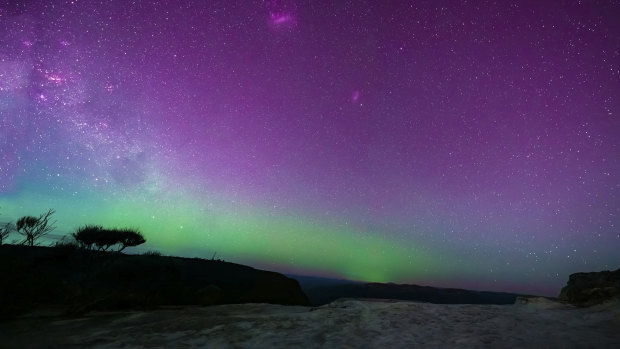'I'm lost for words': Spectacular aurora paints Australian skies
The life of an aurora chaser is not an easy one. Specific solar and atmospheric conditions need to align perfectly for them to indulge their passion fully.

But every 11 years or so, when the poles of the sun flip, if the solar flares that erupt from its surface are facing Earth, and the planet is tilted at the right angle in accordance with the season and the atmosphere is clear (and preferably when the night is young), the persistent aurora chaser will be rewarded with a liquid light show that swallows the sky.
It happened overnight on Thursday and Friday.
After several nights of increasingly dramatic Aurora Australis events, a solar burst rouged the sky from the South Pole to as far north as Queensland, with ribbons of light rippling down from the heavens from around 4.30am on Friday.
“I’m lost for words,” said professional photographer Marc Ilicic, who had visited Tasmania earlier in the week to capture the event, but still managed to witness its greatest iteration from back home on the Gold Coast.
“I don’t think I’ll ever see that again in my lifetime. I never, ever thought I would be able to stand on the Gold Coast and see the lights. It’s really, really special.”
Aurora Australis viewed from the Blue Mountains in the early hours of October 11.Credit: Facebook anonymous
Auroras can typically only be seen in the very far north and south of our planet. But a recent period of extreme solar activity has meant so many charged particles are striking out of our atmosphere that the colourful shows have been seen much further north.
They occur shortly before the sun’s magnetic field flips, when there is a dramatic increase in solar activity that is known as solar maximum. As the sun’s power grows, a huge charge of energy and charged particles from its surface flies towards the Earth. Most of them are deflected by the Earth’s magnetic field, but a few sneak through.
They strike and excite electrons in the atoms of oxygen and nitrogen in the atmosphere. As the atoms release that energy, they glow red and green, which creates the night show of the Aurora.
The last spectacular display occurred on May 11, although Sydney missed out due to cloud cover, and the biggest one before that was 15 years ago.
Daniel Lam, who is an administrator of the Southern Hemisphere Aurora Facebook group, said the best places to observe the phenomenon had little light pollution and a clear view of the southern horizon. Aided by its resident geophysicist, and by examining publicly available satellite reports, the group provides forecasts to amateur aurora watchers, so they know when to watch.
The most recent event was caused by a coronal mass ejection (CME) that took just two days to arrive at Earth, he said. “I expected a possible show that morning and put a camera on timelapse that ran all morning on my south-facing balcony.”
The CME is coming to its end, with no light show expected on Saturday night. Those who missed it are in for another indefinite wait.
The Examine newsletter explains and analyses science with a rigorous focus on the evidence. Sign up to get it each week.
Loading

























































